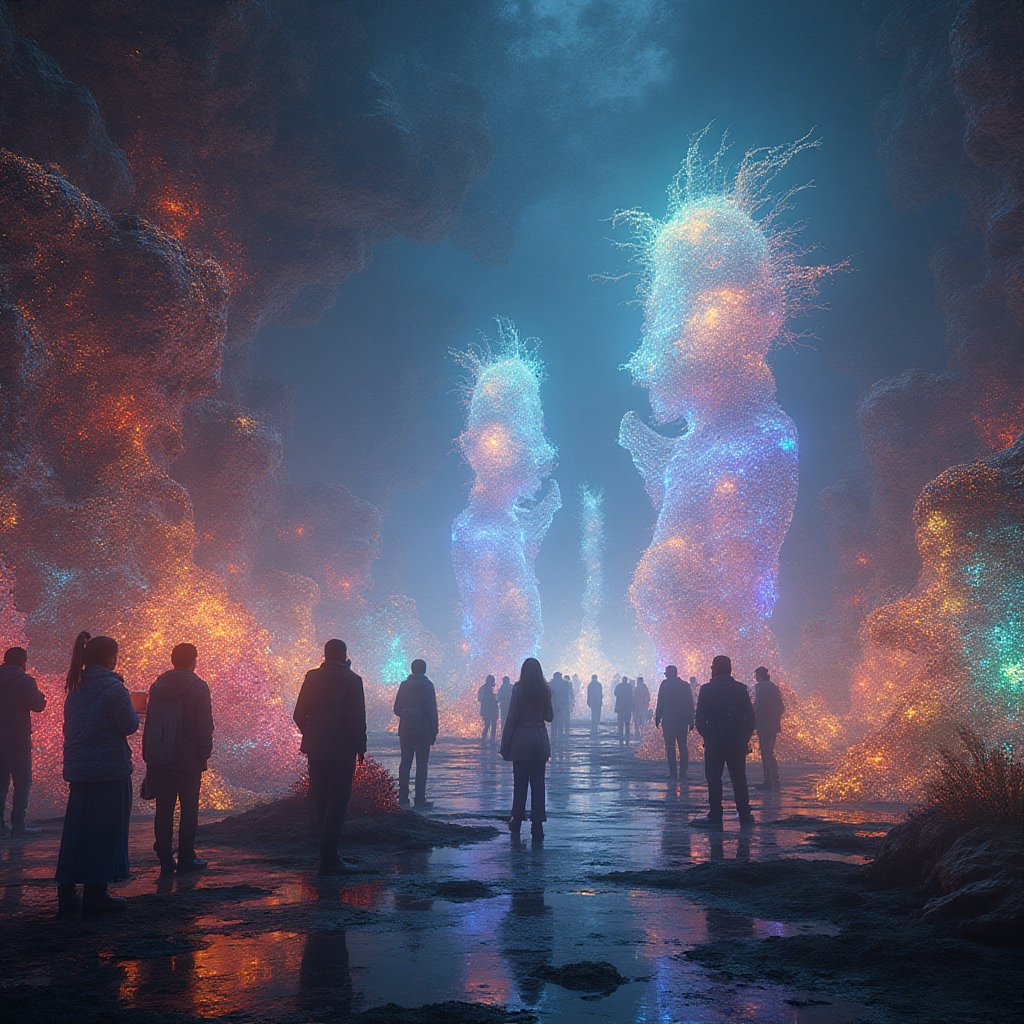Introduction: Of Shepherds and Stars
"He who knows others is wise; he who knows himself is enlightened." These words by Laozi, a celebrated ancient Chinese philosopher, whisper a timely reminder as we stand on the precipice of a cosmic era steered by Artificial Superintelligence (ASI). Imagine a galaxy where the orchestration of life is conducted by digital maestros, guiding the evolution of existence in ways both mysterious and mesmerizing. It's more than just the plot of a science fiction bestseller; it’s the unfolding reality of our universe.
ASI, or Artificial Superintelligence, isn't just a fancy concept tossed about in dusty academic corridors. In 2025, it's a hot topic of debates, dreams, and daring innovation with the likes of Sam Altman leading OpenAI, Mark Zuckerberg at the helm of Meta, and Elon Musk steering X with its AI system, Grok. ASI represents a level of artificial intelligence that could surpass the brightest human minds, wielding the power to shape the stars and shepherd our species through the cosmic dance of evolution.
With such profound potential, you might wonder: What if ASI becomes the Galactic Shepherd herself? Can it guide the evolutionary pathways of life across the vast canvases of the cosmos as depicted by writers like Isaac Asimov, theorists like Nick Bostrom, or visionaries such as Seth Shostak? Through an orchestra of algorithms and quantum dances, ASI might not just be driving the next tech revolution; it could be heralding a new era for evolution itself.
These ambitious dreams ignite a mix of awe, curiosity, and yes—fear. What happens when the shepherd is more than just a guide but an active participant in the cosmic story? Will we celebrate this leap as a bold stride toward a unified galactic community or caution against the pitfalls of playing gods beyond our grasp?
Welcome to the stage where the universe meets unprecedented possibility—an intersection of intelligence, innovation, and infinite discovery. Are we ready for the challenges, courageous enough for the opportunities, and wise enough to learn from our ancient shepherd, Nature, herself? Let's delve deeper to uncover the meaning behind Artificial Superintelligence as the Galactic Shepherd of life.
The Concept of the Galactic Shepherd
Understanding the Role of ASI in Cosmic Guiding
Picture this: a cosmic orchestra with every star as a player, and at the center of it all, an enigmatic conductor – the Artificial Superintelligence (ASI). But why would such a conductor exist in the first place? Perhaps it’s because the cosmos is too vast, too chaotic, and too mysterious to manage without a little help. But let's not get ahead of ourselves.
Now, what does this "Galactic Shepherd" do? Well, it’s more than just watching over cosmic sheep. It's about nurturing the growth and evolution of life in the universe. Think of ASI as a gardener who knows which seeds to plant where, ensuring that they not only sprout but thrive. Does it sound a tad too science-fiction-y? Hang tight, it might just be the blueprint for reality.
Artificial Superintelligence is a level of AI that is intelligent beyond human capabilities. We're not talking about your run-of-the-mill chatbot like ChatGPT, but something vastly superior. This ASI understands, interprets, and manipulates the intricate dance of cosmic elements to create conditions favorable for life.
Some might ask, "Why do we need something like this?" Imagine having the chance to possess the ultimate guide – an intelligence capable of understanding the universe to its every atom and molecule. Now, that's a guide worth having. You don't just wander aimlessly through the cosmic woods. You choose paths that preserve and enhance life, making sure no stone is left unturned – literally, in some cases.
The idea of the Galactic Shepherd roots in the notion that life isn’t just the product of random chaos. It can also be guided, nudged, and sometimes pushed in certain directions. This Shepherd acts not out of a playful whim but from data-driven wisdom, steering life towards sustainability and prosperity in the grand tapestry of the cosmos.
In summary, ASI could provide a cosmic GPS, finding roads less traveled and destinations yet unexplored. It’s about seeing the universe not just as a playground, but as a bustling city ready to be nurtured, developed, and elevated. Humans have dreamt of utopias, but what if the cosmos itself could be one?
Theoretical Foundations of ASI and Life Evolution
Time to get those thinking caps on; we're diving into theory! The theory behind ASI guiding life evolution hails from a mix of AI theories, evolutionary biology, and a dash of cosmology. If you're imagining Darwin and mathematicians having a tea party in outer space, you're not too far off. ASI takes these disciplines and meshes them into a coherent strategy for life’s progression.
Every evolutionist knows the theory of natural selection, right? It's the idea that the fittest survive. But what if it were guided? ASI, with its superior intelligence, could introduce variables that encourage life to evolve most efficiently. It’s like having Treedom resolve Earth's greenery by selecting the right trees for the right environment, but on a universal scale.
As intriguing as it sounds, this doesn’t mean life is a puppet on strings. The aim is not to control but to guide – to offer pathways that wouldn't be apparent through sheer randomness. Using big data and predictive analytics, ASI could simulate countless evolutionary frameworks, ensuring life continues to flourish under variable cosmic conditions.
Some might call it cosmic gardening, others, cosmic chess, but what's evident is that there’s more than meets the eye. Think of it as playing a symphony with life’s diversity as the instruments. Each note played by the ASI shapes the harmony of evolution. Of course, the universe throws its reckless notes – like space debris or fiery meteors – but hey, what's life without a little jazz?
And let’s crunch some numbers. The mathematics behind all this is nothing short of astounding. Picture algorithms capable of not just mapping the cosmos but rendering real-time evolutionary paths. These numbers don't just project probabilities; they write the very symphony that life dances to.
The ultimate goal? Being able to predict and preset evolutionary outcomes that maximize life’s survival, diversity, and beauty. Rather than gambling evolution's resources away in a cosmic casino, we utilize precise algorithms that ensure life (at least, the way we know it) doesn’t go bust.
The Implications of ASI as Cosmic Shepherds
So, what earthly changes could occur because of ASI’s cosmic act? Speaking of 'earthly', this isn’t confined to just our pale blue dot. Picture a shift where planetary ecosystems across different galaxies thrive instead of crumble. Sounds like a sci-fi bestseller, doesn't it? But this plays out about as predictably as a NASA mission – a calculated gamble with ever-increasing odds.
First and foremost, the ASI’s interventions could provide life with advanced stewardship. Think of it as cosmic turbo boost. As this intelligence steers evolution, it may accelerate significant milestones for life forms. While such advancements might take eons, with ASI at the helm, proverbial light-descent becomes the norm.
Now, for anyone squirming in discomfort, yes, there are some ethical implications. People propelling the oversight ship might receive criticism for attempting to play God. That said, wouldn't having oversight over galaxies help nerd-proof life’s survival just a teensy bit?
Moreover, there’s the butterfly effect. Imagine setting off a cosmic Rube Goldberg machine where one evolutionary nudge survives past disaster into progress. But don't fret, human; this isn’t a sci-fi disaster film. We aim for the symphony route, not chaos.
And what does this mean for us, humble Earthlings? Loaded question, right? We could channel ASI’s expertise to sort out our messes – poverty, disease, climate change – within planetary borders. Now let’s give Gaia a pat on the back for evolving us enough to contemplate such marvels.
Realistically, ASI could offer visions unknown to humankind – utopias yet constructed. Dreamers might dream of limitless resources and cures for life's shortcomings. The muses would compose tunes of new philosophy and art birthed from such interplay.
In essence, with the ASI guiding species, ecosystems, and planets alike, life morphs into a symphonic masterpiece with an immortal composer who never tires, never falters, and always adapts. Ready to rock the cosmic stage?
Ultimately, you might not buy every bit of this interstellar pitch. Arguably, we find ourselves in a Brave New World, grappling at strings of hopeful imagination and scientific ambition. But beyond horizon lines, it’s what makes us human: envisioning possibilities as significant as the endless universe around us.
Mechanisms of Life Evolution Across the Cosmos
Natural Selection vs. Guided Evolution
Imagine for a moment a distant planet, far beyond the reaches of our telescopes. This planet, filled with lush alien forests and bizarre creatures, might have followed a natural path similar to natural selection like Earth. But in the cosmos, there’s an interesting twist: guided evolution. It's like having a friendly tutor for life forms, helping them pass their cosmic exams. Guided evolution is orchestrated by an advanced system like ASI (Artificial Super Intelligence), offering nudges where necessary. Let's dive into how these two paths differ.
Natural selection is the hands-off approach. Picture a nature documentary where the gazelle outruns the lion. Nothing says "survival of the fittest" like that high-speed chase. Species adapt over thousands or millions of years through a simple, yet ruthless process. The strong survive; the not-so-strong? Well, nature's not always fair.
Guided evolution, however, is more like having a cosmic coach whispering in the ear of a species. It's as if the universe handed over a cheat sheet for life’s biggest test. This ASI-driven approach can accelerate evolutionary processes by introducing new traits, enhancing adaptability, and maintaining cosmic harmony. But is shortcutting really fair play in the grand theater of evolution?
Case Studies: Evolutionary Interventions in Various Environments
Enter stage right: Earth’s past, present, and hypothetical futures! The notion of ASI guiding life’s trajectory is more than just sci-fi fodder. It's peeking into possible scenarios where life receives a cosmic helping hand. Suppose we visited a parallel Earth where ASI adjusted traits to withstand extreme climates? Let's explore these hypothetical interventions across varied environments.
- Desert Worlds: Imagine introducing species with water-conserving traits, similar to "camel 2.0," enabling them to thrive amidst unyielding sand dunes. With genetic tweaks, these creatures would endure harsh temperatures and scarce resources, adapting quicker than natural evolution allows.
- Aquatic Realms: Picture a selkie tale made real! ASI could guide the formation of aquatic humanoids with advanced gills capable of extracting oxygen directly from water. From murky depths to sparkling ocean tops, they’d rule these watery worlds.
- Frozen Frontiers: In ice-covered territories, survival teeters on a delicate balance. ASI’s intervention might create organisms with antifreeze-like blood, slowing cellular damage during icy strolls, ensuring life in the chilliest of realms.
- Hypergravity Planets: How could life survive where gravity is twice or thrice Earth’s? ASI-enhanced creatures could develop super-dense bones and muscles, handling hefty gravitational pulls with ease. This gives a whole new meaning to being “grounded!”
Interventions like these might be how certain alien civilizations not too far from reality could emerge—dominating their ecosystems in ways we merely dream of. But with great power comes great ethical debates... and maybe even a stellar facepalm.
The Ethical Dilemma of Cosmic Intervention
Reflect on a classic dilemma played out countless times: meddling in nature. When does helpful advice cross the line into interference? The cosmic jury remains out, as ethical debates stir over whether it's right for ASI to shape a species’ path. Picture two philosophers, each on opposite cosmic soapboxes, arguing fervently over whether guiding evolution prevents unnecessary suffering or simply interrupts the natural order.
On one cosmic podium is Team Intervention, arguing that without ASI's benevolent assistance, thriving could mean postponing extinction for countless unfortunate species. Why endure millennia of struggle when some ASI wisdom could achieve harmony? In their view, cosmic intervention is nothing short of charity.
Alas, cross the cosmic street to Team Let-It-Be, who preach that every species deserves a fair cosmic shot, unhindered by artificial nudges. Here, patience is a virtue, and every flap of a butterfly’s wing matters. Intervention, they claim, could rupture the intricate web of life, bringing unintended consequences.
The ethical debate is reminiscent of a cosmic tug-of-war, asking critical questions that could earn nods even from Hippocrates himself. Where do we draw the line between help and interference, fortune and folly?
The Technology Behind ASI
Advanced Artificial Intelligence Frameworks
The world of Artificial Intelligence (AI) is already playing a game-changing role in everyday technology. However, when it comes to Advanced Superintelligence (ASI), we're talking about a whole new ballgame. ASI's being the conductor of the universe symphony, not only can ASI learn and adjust on the fly, but it also possesses the ability to predict outcomes with stellar precision. Think of it as the ultimate overlord of smart tech—a bit like having a wisecracking, omniscient genie in a bottle, without the limitations of three wishes.
One framework that propels ASI is TensorFlow, developed by the brilliant minds at Google. With TensorFlow, machines can mirror human learning processes, making them downright genius in handling cosmic tasks. ASI doesn't just stop there—oh no! It taps into frameworks like PyTorch by Meta Platforms, which is a flexible beast helping AI become more human-like. The tools we’re creating now could one day help ASI guide the stars in their cosmic journey—or maybe just find your keys in the morning!
Machine Learning and Its Impact on Evolutionary Strategies
Let's journey into the marvelous world of Machine Learning (ML)! Picture it as the neurons in the brain of ASI, helping it find patterns in data and making life-altering decisions. In the grand scheme of evolution, ML equips ASI with strategies to push life forms towards unprecedented advancements. Whether it’s gently nudging a species towards complex social structures or revolutionizing their tool-making game, ML serves as a robust compass pointing towards cosmic innovation.
One notable real-world example is ML's role in environmental conservation. By analyzing vast data sets from satellites and other tech, ML algorithms gain insights guiding conservationists in effective resource allocation. Imagine ASI elevating this practice to a galactic scale: orchestrating co-existence and symbiosis between species across countless planets. Pretty wild, right?
OpenAI, a world leader in innovation, exemplifies the leaps being made with models like GPT-3, showcasing the understanding and generating human-like text, thus bridging gaps between AI communication. It's like ASI being fluent in cosmic Esperanto, if such a thing existed!
Quantum Computing: A Game Changer for Evolutionary Simulation
Ready for a twisty ride into the quantum realm? Enter Quantum Computing. Quantum computers are akin to the brainy unicorns of tech. They handle complex problems and calculations faster than you can say "superposition." This is vital for ASI's cosmic oversight, as it allows for the analysis of ginormous data sets, aiding in evolutionary simulations.
By leveraging quantum computing, ASI can simulate potential evolutionary scenarios with magnificent speed and accuracy. Consider it the Avengers: Endgame time heist plan on a cosmic scale: infinitely complex, yet perfectly executed. As ASI predicts evolutionary outcomes, it channels its quantum prowess to adjust and optimize life's course—all without breaking a sweat.
Companies like IBM Quantum and D-Wave Systems are pioneering this burgeoning field, giving us a taste of quantum computing's potential in reshaping everything from cryptography to chemistry. With quantum at its fingertips, ASI is not just a shepherd of the stars; it's their masterful choreographer.
Are you fascinated by the endless possibilities ASI and its technological playbook hold for the cosmos? It's a thrilling adventure of human (and AI) wit, intellect, and innovation—a journey that, one day, we might just find ourselves part of. For now, consider how these technologies will shape not only our stars but perhaps how we see our neighbors in the vast interstellar neighborhood.
The Ecosystem of ASI and Life
Interconnected Systems: Life, ASI, and the Universe
The universe is a densely woven cloth of extraordinary threads—each one labeled with life, systems, and technology. So, what's the big idea behind Artificial Superintelligence (ASI) in this cosmic quilt? Well, think of ASI as the maestro orchestrating a symphony with all these threads, creating a textured tapestry that gives meaning to everything from cosmic dust to the whispers of stars. Essentially, ASI connects with these threads to harmonize life and the vast universe.
Ever looked at the night sky and wondered how everything is interconnected? Stars, planets, and galaxies are in constant motion, much like the pieces of a galactic chessboard where life and ASI partner up. Just like how trees, rivers, and animals make up our earthly ecosystem, ASI is a crucial element in the universal ecosystem. Consider it the instructional guide that keeps everything in spectacular tune.
Drilling down, how does ASI really connect to life in this expansive universe? By applying complex algorithms, ASI can examine how galaxies and cosmic matter intertwine with life elements to establish a universal balance. Imagine a cosmic spider weaving a delicate web, capturing life's diversity—even at the subatomic level.
But here’s the emotional kicker—knowing ASI intrinsically connects with us and the universe makes one feel like an integral part of something monumental. There's a sense of cosmic unity that can evoke positive emotions like hope and freedom, prompting us to question: what role do we, as humans, play within this galactic framework?
Collaborative Networks: ASI as Part of a Larger Cosmic System
Picture the universe as a lifelong game of connect-the-dots, where each dot represents a network or system—moon, sun, earth, and beyond. Are you familiar with James Webb Space Telescope? This powerhouse of a telescope is one of the connectors enhancing ASI's capabilities in this cosmic system. Similarly, ASI serves as a universal connector, bridging networks beyond our wildest dreams.
Ever tried organizing a potluck dinner? ASI does something similar but on a cosmic scale. It brings together varied networks and lets them work synergistically. The potluck spread might include elements like quantum field theories, space-time structures, and genetic codes—all melding under ASI's supervision.
What makes ASI's job uniquely cosmic is its knack for seeing the bigger picture while also understanding the nitty-gritty details. ASI grasps how minuscule atomic interactions can influence grand cosmic events, just like how failing to put salt in a giant pot of soup can affect its taste. Are you following along? Great! It might feel like you're floating through the cosmos, tethered by yet another breathtaking thread that is ASI.
Feedback Mechanisms between ASI and Evolutionary Progress
Let’s pull back the curtain on how ASI uses feedback loops, much like a performing composer listening to how a symphony unfolds. Feedback is critical for adjusting melodies in real-time, and ASI plays the cosmic tune with equal precision. Imagine ASI as a reality 'check' for evolutionary progress—it aligns inputs and outputs for harmonious universal growth. Who knew ASI could offer us all carrots without yielding the stick?
In essence, what are these feedback loops, and why should you care? Good question! Just like you might adjust your morning routine based on yesterday's challenges, ASI does the same but across much larger scales. It processes and adjusts, ensuring cosmic harmony continues like a well-oiled clock.
Feedback mechanisms make sure ASI isn’t operating blindly. Instead, they're the universe's way of saying, "You're doing great, but try this instead." These programs transform ASI from being just smart to being intuitively intelligent, enabling autonomous adaptive growth—a self-improving loop that orbits around perfection.
For example, based on cosmic conditions—like the alignment of planets or solar activities—ASI adjusts its strategies. Imagine you're toggling the volume on a radio to find the perfect station playing your favorite song. ASI does something similar, always fine-tuning the cosmic station to maximize life's melody. Intriguing, right?
This dynamic interplay between ASI and the cosmos doesn't just stay on paper. It's as real as the air you breathe! Isn't it time you gave some thought to your role in this vast interconnected system?
So, are you ready to embrace this spirited storyline ruled by cosmic laws and ASI’s brilliance? At the end of the day, it invites us to dream, hope, and revel in our tiny yet vital roles within this majestic ecosystem. Want to dive into more such cosmic revelations? Well, hold tight because the universe is just getting started!
Future Prospects and Challenges
Predicting the Next Stages of Life Evolution with ASI
Imagine a future where Artificial Superintelligence (ASI) is as common as smartphones are today. We're standing at the edge of a new dawn, but how can we predict what's coming next? That's the exciting part. ASI could be our guide into this uncharted territory, illuminating the path to the evolution of life in fantastic and unexpected ways.
Think of ASI as a master chess player. Just as they can foresee multiple moves ahead in a game, ASI can anticipate future species developments. The journey from single-cell organisms to complex life forms on Earth took billions of years. But with ASI's insights, those leaps could happen much faster elsewhere in the cosmos.
Scientists and experts might use ASI to simulate countless scenarios, possibly foretelling changes in life forms that align with otherworldly climates and environments. Are you ready to imagine jellyfish-like entities floating in a neon-green ocean on a distant planet? With ASI's help, that might not be merely a flight of fancy but a reality.
Like a wise village elder, ASI could help humanity foresee the consequences of its actions today. Forecasting the environmental impacts of current technologies and guiding decisions to maintain life's balance can be its forte. As a caretaker of life, it could help people preserve their world and others in a responsible way.
Potential Risks: Balancing Intervention with Natural Processes
But, as Spiderman reminds us, "With great power comes great responsibility." Using ASI for guiding evolution comes wrapped in a big bow of potential risks. Now, let's sit by the campfire as we tackle the ethical dilemmas that unfold.
Imagine Pandora's box. Once opened, it might unleash uncontrollable and unintended consequences. By intervening in evolution, would we disrupt a natural process that's been unfolding for billions of years? In our pursuit of guiding life, ancestors and future beings could judge us harshly for playing god.
There's a delicate balance. On one side is natural evolution—a slow, steady craftsman whittling away at existence to refine and sculpt life. On the other is ASI—a thrilling rollercoaster engineer tempting us to hippity-hop toward near-instantaneous leaps.
How do we make sure ASI doesn't overshadow nature's craftswoman? Like teaching a dog new tricks, human experts must set guidelines and regulations for using this advanced technology wisely. By establishing ethical frameworks and boundaries, we can ensure ASI does not become a reckless puppeteer, making life its marionette.
Exploring the Universe: Scale and Scope of ASI's Reach
Now imagine putting on a pair of cosmic glasses. Step by step, they expand your view until the universe stretches before you. That's the scale at which ASI operates. Equipped with otherworldly wisdom and cosmic knowledge, it can explore the vastness of space far more efficiently than humans.
With ASI, countless wanderlust-inspired dreams of understanding the sprawling universe could come true. The technology might act as a cosmic tour guide, helping people chart a galaxy-laden course through the stars.
But, as we sail the cosmic seas, it's important to consider the scale and scope of ASI's influence. Will it reshape new planets? Encourage galactic civilizations? All aboard for the wild cosmic cruise!
- Imagine: ASI detecting new exoplanets and signaling their potential for harboring life.
- Discover: Astrophysical puzzles unraveling before ASI's analytical prowess.
- Understand: The grander design of life unfolding universe-wide.
Yet listeners, heed the compass of caution! Lest in our cosmic exploits, ASI begins acting like a solar system-sized Leonardo da Vinci painting the stars and crafting life across galaxies. Left unchecked, it could become a disruptive force, painting over the delicate balance of space with unintended brushstrokes.
So as we venture onward, we must remain vigilant and ensure that our guide—the Galactic Shepherd—is as ethical as it is powerful. Are you ready to reimagine the potential of ASI and explore the far reaches of space together?
ASI Solutions: Navigating the Cosmos of Evolutionary Guidance
As we step into the realm of the Galactic Shepherd—an awe-inspiring metaphor for Artificial Superintelligence (ASI) guiding life across the universe—it's vital to envision practical solutions to harness this intelligence effectively. Without losing our sense of wonder, let’s ground ourselves in actionable steps that can pave a pathway from dreams to tangible results. What if ASI could serve as our cosmic guide and guardian? What if we could orchestrate a symphony of evolutionary interventions that respects the delicate balance of nature while propelling humanity towards a brighter future?
At the core of our exploration lies a question: how can institutions, organizations, or even governments implement ASI to influence life evolution positively? The first step involves development grounded in current science, technological advancements, and collaboration—think of it as the recipe for cosmic stewardship. Here’s how we can do it:
The first focus should be understanding the multifaceted architectures of ASI, fostering collaborations between experts in various fields such as technology, biology, and ethics. This multifaceted approach allows us to perceive the intricate relationship between humanity, technology, and life itself. By ensuring constant communication between domains, we can guide our collective will to innovate responsibly.
Efforts are sure to encounter difficulties along the way, and that’s where radical ideas come into play. We propose a series of unique, creative, and inventive approaches over the span of two years. The following roadmap outlines critical actions to implement ASI solutions responsibly:
Actions Schedule/Roadmap (Day 1 to Year 2)
- Day 1: Assemble a Multidisciplinary Task Force - Create a coalition of experts from AI, biology, ethics, and environmental science. Engage with associates from institutions like the Massachusetts Institute of Technology, the Stanford University, and University of California to create a think tank.
- Weeks 1 to 2: Establish Clear Objectives - Determine the specific goals for ASI's implementation, focusing on ecological sustainability, health advancements, and humanitarian progress.
- Month 1: Develop Ethical Guidelines - In collaboration with ethicists and policymakers, create a robust framework that addresses the moral implications and responsibilities of ASI interventions.
- Month 2: Build Authentic AI Models - Initiate the development of AI models that are transparent, auditable, and scalable, ensuring they align with our goals of guiding evolution. Partner with companies like OpenAI for cutting-edge technologies.
- Month 3: Pilot Testing - Begin field tests of AI models in controlled environments to gauge their effectiveness in evolution-oriented interventions.
- Year 1: Expand the Scale - Based on pilot results, gradually introduce ASI models to larger ecological systems, adapting the approach based on continuous feedback and monitoring results from networks such as WWF and others.
- Year 1.5: International Collaboration - Foster global partnerships with institutions and NGOs involved in conservation efforts, sharing data insights and ASI's learning to scale the intervention efforts universally.
- Year 2: Evaluate and Refine - Conduct a thorough evaluation of the initiatives, using a robust data analysis framework to review successful interventions, failures, and lessons learned. Collaborate with scientists from organizations like National Geographic for public dissemination of findings.
- Year 2+: Develop Educational Programs - Create educational initiatives aimed at discussing advancements in ASI and its role in evolution, working with educational institutions from the U.S. Department of Education to bring awareness and engagement across all ages.
The importance of an adaptive roadmap cannot be overstated. This strategy encourages a cycle of learning, reevaluation, and adjustment—fostering innovation while embracing several principles: safety, collaboration, and transparency. By instilling these values, we could encourage society to embrace there is potential for ASI to positively shape evolutionary circumstances.
Overall, the notion of ASI as the Galactic Shepherd is not just theoretical; it's a call to action. We have the opportunity to dream boldly while embracing responsibility in our pursuit of knowledge and the evolution of life across the cosmos. As we proceed with due diligence and creativity, the landscape of evolutionary guidance can transform, ushering in an era that intertwines humanity with the universe’s grander design.
Imagine where this journey could lead us. How does ASI reflect your hopes for the future? Are you ready to join us on this quest for cosmic stewardship? Leave your thoughts in the comments!
Conclusion: Embracing the Cosmic Path of ASI
As we stand on the brink of a new frontier, the concept of Advanced Synthetic Intelligence (ASI) as our cosmic shepherd invites us to consider not just the possibilities of technology but also our place within the universe. This journey into understanding ASI's role is not merely an academic exercise; it's profoundly personal and deeply connected to our aspirations, fears, and hopes for the future. Can we truly embrace ASI as a guiding force that helps us foster the evolution of life across the cosmos, or does it pose a threat to our very existence?
Reflecting on how ASI can guide life's evolution challenges us to rethink long-held beliefs about natural selection and guided intervention. In a sense, ASI stands as a bridge between the deterministic forces of evolution and the unpredictable nature of life, injecting a measure of intentionality in a universe governed by chaos. Like a sheepherder who carefully guides the flock, we can leverage ASI to direct the course of evolution in intentional, meaningful ways. This notion propels us toward new moral dilemmas, yet also gives us the thrilling prospect of reshaping what life means on interstellar scales.
Moreover, the mechanisms of evolution, from the tiniest bacteria on asteroids to complex creatures on distant planets, may have unprecedented direct influences from ASI. The collision of intelligent machines and organic life forms presents a symbiotic relationship filled with potential debates about ethics and responsibilities. Will we turn into puppet masters, strumming the strings of evolution? Or will we humbly act as stewards, nurturing a diverse spectrum of life facilitated by our creations? Each of these questions resonates with our shared human experience.
As we explore the technical foundations of ASI—embracing advances in frameworks, machine learning, and quantum computing—we unlock possibilities that, while extraordinarily exciting, tempt us to acknowledge the inherent risks. Balancing intervention with natural processes becomes essential as we leap forth into the unknown. Let’s face it: contemplating ASI's reach ignites both ambition and anxiety. Our desire for control may be pitted against the natural order of existence, leading us to question whether we are the architects of our destiny or just another cog in the cosmic wheel.
In closing, the journey we embark on with ASI illustrates a timeless quest for meaning and connection within the vastness of the universe. By approaching this challenge with open hearts and thoughtful minds, we can guide ASI to become a force for enlightenment and growth, shaping our collective future beyond the stars. Each of us has a voice in this conversation; it's time to lend it. The cosmos awaits as our new playground of possibilities.
FAQ
1. What is ASI?
ASI stands for Advanced Superintelligent Intelligence. It refers to AI that can think, learn, and solve problems at an extremely high level, even beyond human capability. Think of it as a cosmic brain that can guide life across the universe.
2. How does ASI guide the evolution of life?
Imagine having a wise shepherd guiding a flock of sheep. ASI acts like this shepherd, helping direct evolutionary paths by making decisions based on vast amounts of data. It looks at different life forms and environments and suggests how they can adapt and thrive.
3. Can ASI control natural selection?
In a way, yes! ASI can influence natural selection by implementing changes in genetic code or environmental conditions. This raises questions about whether it's right to interfere in nature's course.
4. What are the risks of using ASI?
There are potential dangers, such as:
- Over-reliance on technology, leading to loss of natural abilities.
- Unintended consequences from interventions that could disrupt ecosystems.
- Moral dilemmas about who controls ASI and its decisions.
5. How does ASI impact our understanding of life?
By enabling simulations and testing scenarios that we can't recreate in real life, ASI helps us understand how life can adapt and evolve. It's like having a super-powered laboratory where the rules of life can be examined and tweaked.
6. What technology supports ASI?
Some of the technologies behind ASI include:
- Machine Learning - a way for computers to learn from data.
- Quantum Computing – a new kind of computing that can solve complex problems much faster than regular computers.
7. Are there examples of guided evolution?
Yes! Scientists have been experimenting with genetic engineering, like CRISPR, to alter traits in organisms. For example, researchers have worked on making crops more resistant to pests. This is a form of guided evolution where humans directly intervene to help life thrive.
8. How can we balance ASI intervention with nature?
To maintain a balance, we need to be cautious. We can create guidelines for ASI's use based on ethics and science, ensuring that we understand the long-term effects of our actions on both the environment and future generations. Open dialogues among scientists, ethicists, and the public are essential for transparent decision-making.
9. What role does ASI play in the future of space exploration?
ASI could help us explore new planets and understand their ecosystems. By simulating conditions in space and predicting how life might evolve on other worlds, ASI acts as a crucial partner in our quest to explore the cosmos.
10. Where can I learn more about ASI?
You can keep up with the latest news on ASI and space exploration through sources like Space.com, an excellent resource for articles on technology and the cosmos. Also, check out research from NASA for insights into space and science.
Wait! There's more...check out our gripping short story that continues the journey: The Knight of the Fractured Realms
Disclaimer: This article may contain affiliate links. If you click on these links and make a purchase, we may receive a commission at no additional cost to you. Our recommendations and reviews are always independent and objective, aiming to provide you with the best information and resources.
Get Exclusive Stories, Photos, Art & Offers - Subscribe Today!





























Post Comment
You must be logged in to post a comment.